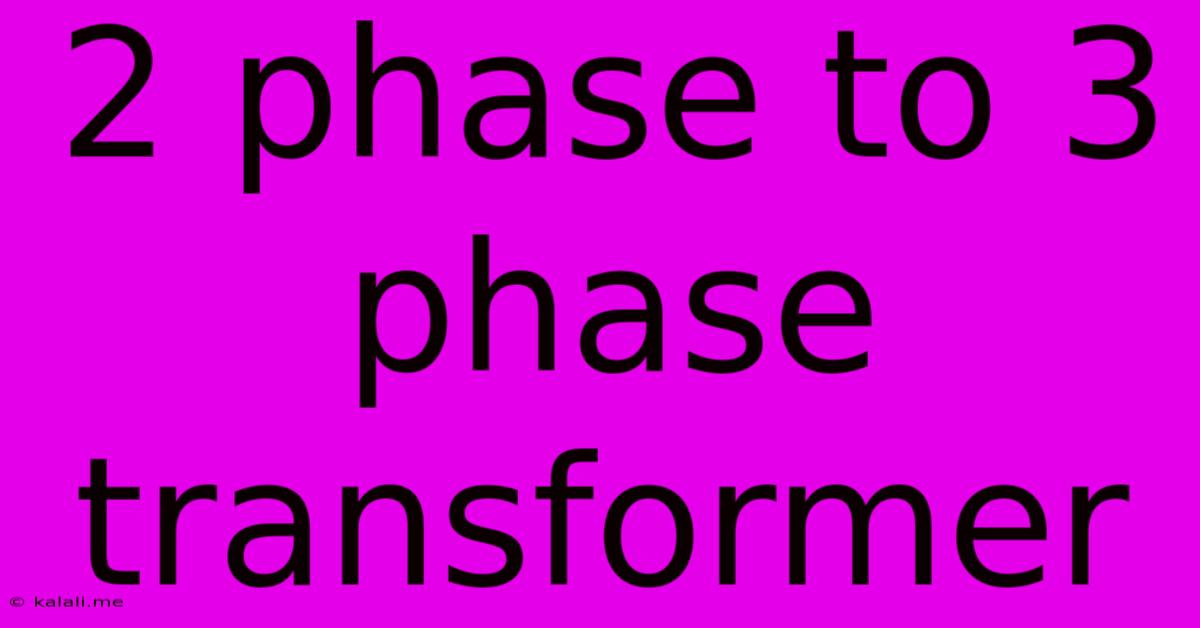2 Phase To 3 Phase Transformer
Kalali
May 28, 2025 · 3 min read

Table of Contents
2-Phase to 3-Phase Transformer: A Comprehensive Guide
A 2-phase to 3-phase transformer is a specialized piece of electrical equipment used to convert a two-phase power supply into a three-phase power supply, or vice-versa. This conversion is crucial in situations where you have a legacy two-phase system and need to integrate with a three-phase infrastructure, or conversely, need to supply power to equipment requiring a two-phase supply from a three-phase grid. This article will delve into the functionality, applications, types, and considerations when working with these transformers.
What is a 2-Phase Power System?
Before we dive into the specifics of the transformer, it's important to understand that true two-phase systems are relatively uncommon today. What is often referred to as a "two-phase" system is typically a two-phase four-wire system, derived from a quarter-phase system with two separate windings offset by 90 degrees. This is different from a three-phase system where the phases are 120 degrees apart. The older two-phase systems are mostly found in older buildings or industrial sites.
How a 2-Phase to 3-Phase Transformer Works
The conversion process isn't a simple voltage transformation. It involves a more complex arrangement of windings and often requires additional components. The core principle lies in utilizing the phase shift between the two-phase supply to create the necessary phase relationships for a three-phase output. This is achieved through a cleverly designed configuration of windings within the transformer core, which mathematically manipulates the input signals. Several different connection methods exist to achieve this transformation, each with its own advantages and limitations in terms of efficiency and harmonic distortion. Common methods employ Scott-T connections or other specialized winding arrangements.
Types of 2-Phase to 3-Phase Transformers
Several variations exist based on the specific configuration and application:
-
Scott-T Transformers: This is a common configuration employing two transformers to achieve the conversion. One is a main transformer with a winding tapped at 86.6% of its total length, while the other is a smaller "teaser" transformer. This configuration is known for its relatively simple design and decent efficiency.
-
Three-winding Transformers: Some 2-phase to 3-phase conversions might utilize a single transformer with three separate windings to directly generate the three-phase output.
-
Transformer with Phase Shifting Components: More complex setups might involve additional phase-shifting components alongside the transformers to optimize the output wave form.
Applications of 2-Phase to 3-Phase Transformers
These transformers are specialized and their applications are niche, often found in:
-
Power Supply Upgrades: Converting older two-phase systems to modern three-phase systems for better efficiency and compatibility with new equipment.
-
Industrial Equipment: Supplying power to older machinery designed for two-phase power from a modern three-phase grid.
-
Legacy Building Retrofits: Modernizing older structures where two-phase power was originally installed.
-
Specialized Industrial Processes: Certain specialized industrial processes might require specific phase arrangements accommodated by these transformers.
Considerations When Using 2-Phase to 3-Phase Transformers
-
Voltage and Current Ratings: Ensure the transformer's ratings match the input and required output parameters. Incorrect ratings can lead to overheating or damage.
-
Harmonic Distortion: Certain configurations can introduce harmonic distortions. Choose transformers with low harmonic distortion characteristics for sensitive equipment.
-
Efficiency: The efficiency of the transformation process will impact energy costs. Look for high-efficiency transformers.
-
Cooling: Adequate cooling is essential to prevent overheating. Pay close attention to the cooling requirements specified by the manufacturer.
Conclusion
2-phase to 3-phase transformers are crucial for bridging the gap between older two-phase systems and modern three-phase infrastructure. Understanding the different types, configurations, and operational considerations is vital for proper selection and effective implementation in diverse applications. Always consult with qualified electrical engineers for the design and implementation of any electrical system involving these specialized transformers. Improper installation or use can be dangerous.
Latest Posts
Latest Posts
-
Is Another Word For Absolute Value Sum
May 30, 2025
-
Do Panko Bread Crumbs Go Bad
May 30, 2025
-
How To Remove Labels From Wine Bottles
May 30, 2025
-
Can You Lay Vinyl Flooring Over Tile
May 30, 2025
-
How Do You Find Your Whatsapp Number
May 30, 2025
Related Post
Thank you for visiting our website which covers about 2 Phase To 3 Phase Transformer . We hope the information provided has been useful to you. Feel free to contact us if you have any questions or need further assistance. See you next time and don't miss to bookmark.